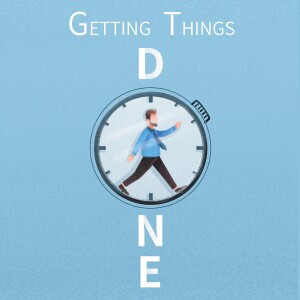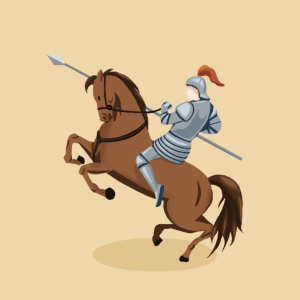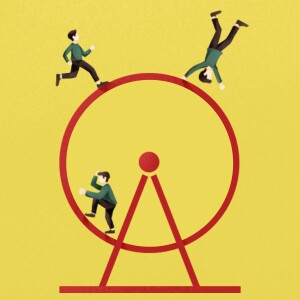Episodes

Thursday Jun 01, 2023
Thursday Jun 01, 2023
Getting To Yes
Getting To Yes Full Book Introduction
Negotiation is closely related to our lives. Buyers and sellers bargain over the price of a product. Employees strive for a promotion or a pay raise from the boss. Children debate their parents over what time to go to bed at night. These are all familiar negotiation scenes in our daily lives. Everyone is a negotiator, and those who are better at negotiation meet their needs more efficiently. Getting to Yes: Negotiating Agreement Without Giving In presents the research results of the Harvard Negotiation Project. This book will teach you how to negotiate more efficiently and help you achieve win-win outcomes!
Author : Roger Fisher, William Ury, Bruce Patton
This book was written by three senior experts from the Harvard Negotiation Project: Roger Fisher, William Ury, and Bruce Patton. They specialize in researching negotiation and often present lectures about their findings to companies and government agencies. They also accumulate a lot of practical experience with negotiation through providing negotiation consulting services. For this reason, their book has been hailed as “the authoritative guide in the field of negotiation.”
What are the drawbacks of positional bargaining? | Chapter 1
First, let’s explore part one to understand what positional bargaining is, as well as some of its drawbacks.
The most common phenomenon during negotiations occurs when both parties stand firmly on opposing sides in their respective positions and defend their interests. When both parties equate the idea of defending their positions with safeguarding their dignity, the negotiation is less likely to achieve consensus. Therefore, many negotiations eventually evolve into battlefields where both parties argue just to maintain their image. They simultaneously try to overwhelm the other party to such an extent that they forget their original interests. This common situation is what the book refers to as “positional bargaining.”
Let’s look at an example of “positional bargaining.” Two children wanted to share a piece of cake. Their original intention was to distribute the cake equally, but while talking, one began to emphasize, “I am older, so I should eat a little bit more.” In contrast, the other started to stress, “I am strong, so I should eat a little bit more.” As a result, both parties gradually came to stand in their respective positions. They turned the focus of the negotiation into who is older or stronger. They ignored the fact that their fundamental interest was eating the cake. The scenario that we just described represents a typical case of "positional bargaining."
So, what are the drawbacks of “positional bargaining”?
Firstly, the results of “positional bargaining” often fail to meet both parties’ needs simultaneously, meaning that it is challenging to produce win-win outcomes. Specifically, this failure implies two possible results: either one party wins and the other loses or both parties lose.
Let's talk about the first outcome, where one wins and the other loses. This situation often occurs when one side’s status is unequal to the others, such as negotiations between strong and weak countries, Party A and Party B in a contract, leaders and subordinates, and so on. Generally speaking, the party with higher status will take stricter measures, while the weaker party will be more mild-mannered. Suppose both sides get themselves into a “positional bargaining” stance. In this case, it usually results in the strong dominating and taking advantage of the weak, while the more vulnerable party compromises to avoid additional friction.
The second outcome occurs when both parties lose as the negotiation breaks down. Let’s look at an example. During President John F. Kennedy’s reign, the United States and the Soviet Union negotiated a total ban on nuclear testing. One of the topics was about how many inspections would be allowed each year in areas suspected of nuclear testing activities in their own territory. The United States insisted on at least ten inspections, while the Soviet Union insisted on only three. Neither side wanted to make concessions, and eventually the talks broke down. This example illustrates the second possible result when “positional bargaining” fails to achieve beneficial outcomes: both parties lose.
However, is it really impossible to reach a consensus on this issue? The United States advocated for ten inspections per year while the Soviet Union advocated for three per year. Thus, the two countries seemed caught in a deadlock. However, the authors point out that they could have taken a different approach and discussed the design of inspection procedures. For instance, by focusing on the number of days an inspection might last and the number of people it might take for each country to inspect nuclear tests in their respective territories, they might discover that they could send one person to inspect for one day or 100 people to inspect for one month. Considering the issue from this perspective might have allowed them to satisfy the United States' demand for more inspections and the Soviet Union's request to reduce interference from the other side. This way, perhaps the negotiations could have continued. However, because both parties were uncompromising and stuck to their respective positions, they failed to consider a plan that would satisfy both parties.
Next, let’s look at the second drawback of “positional bargaining”: inefficiency.
This disadvantage is not hard to understand. When two parties hold opposite views on an issue, they tend to either stick to their positions or frequently alter negotiation terms to test each other’s bottom line. However, wasting time on such pointless arguing only leads to inefficient negotiation processes. If any party takes an extreme initial position, the possibility of finding a compromise also decreases, thus increasing the time needed for negotiations.
Let’s look at the typical example of a customer bargaining with a shopkeeper in a clothing store. The shopkeeper asks for $100, while the customer bargains for $20. The shopkeeper thinks that the customer does not know the item’s real value and is being insincere in their offer. On the other hand, the customer believes that the shopkeeper sets their prices randomly, which is not kind. As a result, the topic of dispute becomes whether they know the goods’ actual value and whether the price is set randomly. Then, the shopkeeper switches his reasoning and says that the production alone costs him $80. Still, the customer states that the item is only worth $30 considering its quality. Thus, the negotiation topic has changed again to the cost versus the quality of the clothes. The price continuously changes from $80 to $60, and from $30 to $40. During the process, the buyer often threatens to pull out of the deal if the shopkeeper doesn’t want to lower the price. Time flies as the two sides bargain back and forth.
Maybe the shopkeeper and the customer eventually make a deal at a certain price. Nevertheless, they wasted 15 minutes just to strike a bargain. Do you think this process is very inefficient? It is even more likely that the two sides fail to reach a deal even after bargaining for more than 15 minutes.
The third drawback to “positional bargaining” that cannot be ignored is the possibility of endangering an ongoing relationship.
Since both sides have different demands, it is easy for each negotiating party to treat the other as an enemy that must be defeated. Thus, confrontation arises from the negotiation process. When one party finds that their reasonable demands are not taken seriously, they may become angry and or even more aggressive. As a result, the ongoing relationship is endangered.
We are now coming to the end of part one. We learned about three drawbacks of “positional bargaining” that commonly occur in daily life: producing unbeneficial outcomes, inefficiency, and endangering ongoing relationships.

Thursday Jun 01, 2023
Thursday Jun 01, 2023
Getting Things Done
Getting Things Done Book Introduction And Review
Do you often complain about not having enough time or having a lot of work to do? Getting Things Done: The Art of Stress-free Productivity will help you solve all your problems. This book introduces a method called GTD time management. It is an efficient workflow practice proven to help you "Win at the Game of Work and Business of Life." This book is based on the author’s over 30 years of consulting experience and personal exploration. It has been published in 33 countries, helping millions of readers around the world to get their work done easily and efficiently.
Author : David Allen
David Allen, an American author, is the founder of David Allen Company, a management consulting enterprise. He is one of the most influential thinkers in improving work efficiency and a leading authority in the field of time management. He created the GTD time management method and was recognized by Forbes as one of the foremost executive coaches in the U.S.
Overview | Chapter 1
Hi, welcome to Bookey. Today we will unlock the book Getting Things Done: The Art of Stress-free Productivity.
Are you confused when you are busy as a bee every day at work but can’t get the promotion or income you expect? Do you still have a lot of work to do when it is time to go home? Most of us are annoyed by tight schedules, a heavy workload and too much stress.
It seems that the reason these things happen is because we have too much work to do – but in fact, we have poor time management skills. No matter if you want to lose 40 pounds, take control of your financial destiny, disentangle your family relationships or pursue your dreams, you will need to manage your time to improve productivity. The method introduced in this book is GTD time management. It is a set of proven and highly efficient workflow practices which can free you from excessive work and enable you regain control of your life.
GTD is short for "Getting Things Done" and it simply means to get things done. This method has been popular worldwide for more than a decade. Many people even greet others by saying, "Are you GTD today?" You can see how great the impact is.
The book is written by David Allen, an American training expert with more than 30 years of experience in management and pioneering research on improving productivity. He has spent thousands of hours helping people in "work trouble" to manage their work. This book is a collection of the author's practical experiences over the years, and it will guide you to produce maximum output with minimum effort.
The nature of time management is to manage our minds and actions. GTD time management holds that the most important point is to move all distracting work arrangements out of your brain through some external tools and techniques. In this way your brain remains relaxed and happy. GTD time management methods can make you more successful, and more importantly, help you live a happy life.
In this Bookey, we will talk in detail about the four parts of the GTD time management method.
Part one: how to prepare for GTD time management?
Part two: the five stages of lateral mastering work flow.
Part three: the five phases of longitudinal project planning.
Part four: the three keys to yielding twice the result with half the effort.
These four parts will help you to set up your time management system. Now let's begin to talk about them, one by one.

Thursday Jun 01, 2023
Thursday Jun 01, 2023
Crucial Conversations
Crucial Conversations Full Book Introduction
Inevitably, there will be “crucial moments” in our lives that are difficult to solve but will have a significant impact on the overall course of our life. However, most people handle these moments poorly, and even choose to avoid them. This book teaches us practical skills to handle crucial conversations, avoid unnecessary arguments, and achieve effective communication. This book is based on over 20 years of empirical research and data gathered from more than 100,000 people around the world. The skills described here have been adopted by more than 300 of the Fortune 500 companies, and the book has sold 3 million copies in the United States.
Author : Kerry Patterson, Joseph Grenny, Ron McMillan, Al Switzler
The four authors of this book are Kerry Patterson, Joseph Grenny, Ron McMillan, and Al Switzler. This group of authors includes researchers at Stanford University, corporate lecturers, and senior consultants. In addition to this book, the team also published Crucial Confrontations—Tools for Resolving Broken Promises, Violated Expectations, and Bad Behavior, Change Anything: The New Science of Personal Success, and Influencer: The New Science of Leading Change, which all made the New York Times Bestsellers list and had a positive impact in various fields.
Overview | Chapter 1
Hi, welcome to Bookey. Today we’ll unlock the book Crucial Conversations: Tools for Talking When Stakes are High.
When people first hear the term “crucial conversation,” it may conjure up images of Apple and Google’s lawyers fighting a patent dispute in court, or politicians from various countries gathered at a round table in Geneva to hold an international conference. Although discussions like these indeed have a wide-sweeping impact, they’re not the subject of this book. The crucial conversations we’re referring to are interactions that everyone experiences. They’re the day-to-day conversations that affect your life, such as the following scenarios: Imagine that you are facing harassment from your boss, and if you choose to tolerate it, he will continue; if you fight back, the next day, he may fire you for walking into the office with your left foot first. Or at home, imagine that your spouse intentionally or unintentionally alienates himself or herself from you. If you choose to let the situation escalate to a cold war, then your marriage will be on the rocks. But if you fight back, it may just make your spouse withdraw even more. These situations are actually crucial moments in our lives, and the result of these conversations will have lasting positive or negative effects, leaving a huge impact on the quality of our lives. Unfortunately, most people do not handle crucial conversations in the right way. In this case, the book Crucial Conversations: Tools for Talking When Stakes are High proposes two principles: clarify what you really want and create a safe atmosphere that helps us seize every crucial moment in our lives.
This book is co-authored by a team of four authors. Kerry Patterson did doctoral work in organizational behavior at Stanford University. He is a recipient of the 2004 William G. Dyer Distinguished Alumni Award from Brigham Young University’s Marriott School of Management. Joseph Grenny has been a senior consultant in the field of corporate change research for more than 30 years. He is also a co-founder of a non-profit organization, which works to eradicate poverty around the world. Ron McMillan, an acclaimed speaker and senior consultant, is the co-founder of the Covey Leadership Center, where he serves as Vice President of Research and Development. Al Switzler is on the faculty of the Executive Development Center at the University of Michigan and has helped dozens of Fortune 500 companies. After 20 years of research involving more than 100,000 people around the world, the team selected a group of great conversationalists, analyzed their common characteristics and behaviors in crucial conversations, and narrowed down a set of effective methods, which are the basis of this book.
Next, we’ll introduce the book in three parts.
Part one: The purpose of mastering crucial conversations
Part two: The first principle of crucial conversations: focus on what you really want
Part three: The second principle of crucial conversations: create safe environment.

Thursday Jun 01, 2023
Thursday Jun 01, 2023
21 Lessons For The 21st Century
21 Lessons For The 21st Century Book Introduction And Review
Artificial intelligence has already entered our lives. While we enjoy the convenience it brings us, we are also worried that it might take our jobs, access our data, and make decisions for us. Given the numerous challenges we will be facing in the future, how do we make sure we can stay at the forefront of time and survive? Following Sapiens: A Brief History of Humankind and Homo Deus: A Brief History of Tomorrow, as the finale of the trilogy, the book 21 Lessons for the 21st Century will bring you to a significant discussion about human destiny in the twenty-first century.
Author : Yuval Noah Harari
The author of this book is Yuval Noah Harari, an Israeli writer, also known as “the young geek“. Not only does the book take a historical perspective, but also covers a wide range of knowledge areas, such as biology, sociology, psychology, philosophy, and religion, fully demonstrating the author’s extensive knowledge. Unlike traditional historians, Harari, being creative, makes videos based on the content of his book and uploads them on YouTube, gaining a large number of young fans.
Overview | Chapter 1
Hi, welcome to Bookey. Today we will unlock the book: 21 Lessons for the 21st Century.
According to statistics from the Internet Data Center (IDC), the amount of data generated globally in the year 2008 was zero point four nine zettabytes (ZB). If we assume that a book has 200,000 words, that amounts to an equivalent of fourteen hundred trillion books, which can fill two hundred and eighty thousand libraries. By 2011, the amount of data had increased by two point seven times, which equals to an average increase of 250,000 libraries per year.
Fortunately, artificial intelligence (AI) can process a great amount of data, and allows us to enjoy the technological advancement it brings to our lives. However, when we benefit from technology, have we ever thought about the possibility of AI taking our jobs, accessing our data, and even making decisions for us? When it comes to this point, how will we survive?
The book, 21 Lessons for the 21st Century by Harari discusses this exact question. Not only does it take a historical perspective, but it also covers a wide range of knowledge areas: biology, sociology, psychology, philosophy, and religion. The author believes that individuals can have a direct influence on the world.
Known as the young geek, Yuval Noah Harari is a historian who obtained his doctoral degree from the University of Oxford. Besides this book, he has published another two global bestsellers, Sapiens: A Brief History of Humankind and Homo Deus: A Brief History of Tomorrow, completing his trilogy.
Unlike the other two books, the one we are going to discuss today is more instructive. It focuses more on the challenges people are facing at the present moment. It gained enormous popularity and wide attention around the world since it was published, and has so far been authorized for publication in over twenty countries.
This book has selected twenty-one significant topics on the solutions relevant to the future of humans. This Bookey will divide them into three main parts.
Part One talks about the challenges the information explosion era poses to human beings;
Part Two is about how individuals can find the truth;
Part Three looks at how individuals can prepare for the future.

Thursday Jun 01, 2023
Thursday Jun 01, 2023
Thinking, Fast And Slow
Thinking, Fast And Slow Book Introduction And Review
The human brain is equipped with two thinking systems, System 1 that is good at thinking fast, and System 2 that is good at thinking slow. System 1, the fast thinker, relies on intuition when it makes a judgment. While it is fast and efficient, it is inept at statistical reasoning and is susceptible to many systematic biases. On the other hand, System 2, the slow thinker that oversees rational thinking, is lazy and often takes System 1’s intuition for granted. More often than not, we are irrational when we make judgments and decisions, and we are definitely not what the author calls “Econs.”
Author : Daniel Kahneman
Daniel Kahneman is a psychologist and a pioneer in behavioral economics. He was awarded the 2002 Nobel Memorial Prize in Economic Sciences for bringing psychology and economics together to better understand how humans make decisions under uncertainty. His research has covered social psychology, cognitive science, and behavioral economics. Documenting his pioneering findings in these fields, the 2011 book Thinking, Fast and Slow is an ensemble of Kahneman’s finest works.
Overview | Chapter 1
Hi, welcome to Bookey. Today we will unlock the book Thinking, Fast and Slow, a milestone in the field of behavioral economics.
Daniel Kahneman, the renowned psychologist and author of the book, has combined psychology and economics to examine how humans make judgments and decisions under uncertainty. His trailblazing work won him the 2002 Nobel Memorial Prize in Economic Sciences. By collaborating with his colleague Amos Tversky, Kahneman paved the way for a new field of study, Behavioral Economics. Their research broke down the barriers between social psychology, cognitive science, and economics, providing us with a better understanding of the mechanisms of the human brain in judgment and decision making.
Psychologists Keith Stanovich and Richard West were the first to propose that the human brain runs two cognitive processes, fast thinking and slow thinking, which they named System 1 and System 2. These terms were adopted by Kahneman in this book.
System 1 and System 2 are not two physical parts in the human brain but a virtual concept that showcases how thinking works. System 1 is a subconscious, fast-thinking system that relies on intuition, whereas System 2 is a conscious, slow-thinking system that takes voluntary effort to control. System 1 is in charge of the day-to-day tasks that we are familiar with, such as braking or turning according to signals when we drive. On the other hand, System 2 takes over the tasks or problems that System 1 finds alien or fails to solve, such as doing the mental arithmetic of 17 times 38.
Although the human brain has two thinking systems at its disposal, System 2 is, in fact, very lazy. It would not set to work unless the situation compels it to, such as when faced with a problem that System 1 cannot solve. As a result, most of the judgments and decisions that we make for our lives and career are predominantly System 1’s works. System 2 is at best its assistant. In most circumstances, the work distribution between System 1 and System 2 is highly efficient. However, System 1 has many flaws and is prone to systematic errors, which is what Kahneman chose to focus on in this book. He mainly discusses the cognitive attributes and weaknesses of System 1. By understanding System 1’s flaws, we can consciously avoid many cognitive fallacies and become better decision-makers.
Next, we will summarize the book in three parts by focusing on the traits and flaws of System 1 when it makes decisions; and why we are not rational Econs.
Part One: System 1 makes judgments based on intuition
Part Two: System 1 is inept at making statistical judgments
Part Three: We are not rational Econs

Thursday May 18, 2023
Thursday May 18, 2023
Don Quixote
Don Quixote Full Book Introduction
The book revolves around the adventures of a middle-aged man of the lowest nobility. After reading so many chivalric romances, he loses his mind to become a knight-errant and save his country. After recruiting Sancho Panza as a squire, the two embark on their adventure.
Author : Miguel De Cervantes Saavedra
It is widely considered that Miguel de Cervantes Saavedra was one of the world's greatest novelists and the greatest writer of the Spanish language. Don Quixote is his greatest work, widely recognized as the first modern novel and the pinnacle of world literature.
Overview | Chapter 1
Hi, welcome to Bookey. Today we will unlock the book Don Quixote. It is a classic novel by Miguel de Cervantes in the early 17th century. It follows the adventures of a middle aged man named Alonso Quixano, who becomes convinced he is a knight and sets out on a quest to right wrongs and defend the helpless. Accompanied by his loyal squire, Sancho Panza, Don Quixote encounters a series of comical and often absurd situations as he tries to live up to his chivalrous ideals. He battles windmills, challenges a group of priests to a duel, and even rescues a damsel in distress. Despite his well-meaning intentions, Don Quixote's actions often cause chaos and confusion, leading to humorous misunderstandings and misadventures. As he continues his journey, he begins to question the nature of reality and the role of imagination in shaping our lives.
The novel explores themes of idealism, delusion, and the power of imagination to transform our world. The novel has been widely celebrated for its humor, satire, and exploration of human nature.
The author of this book, Miguel de Cervantes, was born in 1547 in Alcalá de Henares, Spain. In Western literature, he is regarded as one of the greatest Spanish novelists, poets, and playwrights. Cervantes began writing at a young age and published several plays and poems before becoming a soldier in the Spanish Navy. He fought in many battles, including the famous Battle of Lepanto, where he was wounded and captured by pirates. After being released from captivity, Cervantes returned to Spain and continued to write. In 1605, he published the first part of Don Quixote, which quickly became a literary sensation and established Cervantes as one of the leading writers of his time. The second part of the book was published in 1615, and the complete novel was published in 1620. Cervantes died in Madrid in 1616, but his legacy as one of the greatest writers in history lives on.
Moreover, the impact of Don Quixote has been profound and enduring. It is widely considered one of the greatest works of literature of all time, and its influence can be seen in countless other works of literature, art, and popular culture. The book's hero, Don Quixote, is a timeless symbol of the individual's struggle against the forces of conformity and oppression, and his unyielding idealism and courage have inspired countless readers to believe in themselves and their ability to change the world. Additionally, the novel's clever satire and brilliant storytelling have made it a beloved classic, and it continues to be read and enjoyed by people of all ages and backgrounds. In short, the impact of Don Quixote has been nothing short of revolutionary, and its lasting legacy is a testament to the power of great literature to inspire and transform the human spirit.
Now, we will focus on Don Quixote’s adventures in three parts.
In Part One, we will provide a plot summary of Don Quixote’s adventures.
In Part Two, we will depict the key characters, like Don Quixote, his squire and lady love.
In Part Three, we will elaborate on the style and theme.

Thursday May 18, 2023
Thursday May 18, 2023
The Richest Man In Babylon
The Richest Man In Babylon Full Book Introduction
Babylon, one of the four ancient civilizations, was a wealthy nation with countless gold and jewels but with limited natural resources. Its brilliance was entirely the result of human wisdom. The Richest Man in Babylon introduces ancient wisdom from 5,000 years ago and reveals how Babylon got rich. You will become enlightened about wealth and understand its most fundamental laws. These oldest and most effective laws of wealth can guide you from being penniless to success and happiness.
Author : George S. Clason
George S. Clason was a famous American financial master, businessman, and writer. He was the pioneer of modern wealth management education. Starting in 1926, Clason published a series of hugely popular wealth management pamphlets, using ancient Babylonian fables to illustrate his views on work and financial issues. The pamphlets caused a stir in the financial world and soon became familiar to millions of people. They were later published together in the book, The Richest Man in Babylon.
Overview | Chapter 1
Hi, welcome to Bookey. The book we are unlocking today is The Richest Man in Babylon.
In the annals of history, Babylon was no doubt a shining star. It had gold and jewels in abundance, and rich people could be found everywhere. You may think the wealth was due to its natural advantages, just as the wealth of the United Arab Emirates is related to its oil abundance today. On the contrary, Babylon was situated in a barren, arid valley near the Euphrates. The natural environment was extremely harsh. There was nothing of value, and it was not along any of the main trade route. Many wealthy Babylonians were not born rich, and Babylon's success was not a gift from heaven. The success was the result of the hard work based on the wisdom of the Babylonians through generations.
As Babylonians, their priority was to learn how to become wealthy. The king of Babylon once ordered the establishment of a lecture hall that could hold 100 people, so that the richest man in Babylon, Arkad, could teach people the secrets of getting rich. Arkad shared all the lessons learned over the years and asked those in the lecture hall to pass those lessons on to others.
Good things never go out of style, and these self-made ways of making money still work in today’s world. In 1934, a couple of archaeology professors at the University of Nottingham translated the cuneiform script on five unearthed Babylonian clay tablets. By doing so, they learned the astonishing secret of how an ancient Babylonian slave paid off his debts. They tried out the method written on these tablets, and they not only paid off old debts, but also accumulated a considerable amount of savings. This ancient wisdom we just mentioned came from The Richest Man in Babylon. The book uses fables to narrate the path to success from some of Babylon’s super-rich.
The author of this book, George S. Clason, was a famous American businessman and writer in the 20th century. He once published the first road atlas of the United States and Canada, and had quite deep experience in the publishing industry. He was also a master of wealth management, known as the pioneer of modern wealth management education. Starting in 1926, Clason published a series of wealth management pamphlets, using ancient Babylonian fables to illustrate his views. The pamphlets caused a stir in the banking industry and the insurance industry. They soon became familiar to millions of people, and were later published together in the book, The Richest Man in Babylon. The book has been translated into many languages and still sells well today.
In this bookey, we will reveal the secrets of Babylon’s riches in three parts:
Part One: How to accumulate the first bucket of gold;
Part Two: How to make money work for you;
Part Three: How to keep your money.

Thursday May 18, 2023
Thursday May 18, 2023
The Power Of Habit
The Power Of Habit Full Book Introduction
Do you think that your daily routine is the product of well-considered decision-making? In reality, it's anything but that. We are primarily driven by our habits, which, once formed, are there to stay. However, once we understand the way habits function, it becomes easier for us to control them. The Power of Habit is an in-depth analysis of habits. It shows how developing new habits can transform our lives beyond recognition.
Author : Charles Duhigg
Charles Duhigg is a former New York Times reporter who currently writes for The New Yorker magazine. He studied history at Yale University and received an MBA from Harvard Business School. He is an author of many bestsellers, including The Power of Habit and Smarter Faster Better, and a recipient of the Pulitzer Prize, the United States National Academies Communication Award, the National Journalism Award, the George Polk Award, the Gerald Loeb Award, and other accolades. He has also contributed to American Life, The Dr. Oz Show, and other periodicals throughout his career.
Overview | Chapter 1
Hi, welcome to Bookey. Today, we'll unlock the book The Power of Habit: Why We Do What We Do in Life and Business.
What do you do first thing in the morning? Brush your teeth, wash your face, take a shower, or eat your breakfast? Do you tie your left or right shoe first? Which route do you take to work? When you arrive at the office, do you first check your email or make small talk with your colleagues? Do you eat a healthy salad or a hearty steak for lunch? After you get home in the evening, do you exercise or make your dinner first?
You may think that all of these choices are the result of deliberate thinking, but they are not. Most of those actions are the byproduct of your habitual patterns. According to research published by Duke University in 2006, 40% of peoples' daily activities are born from habits, not decisions made after careful consideration.
Habits play an essential role in our lives. Over time, they profoundly impact our health, productivity, financial security, and happiness. As a result, we all want to develop good habits or break bad ones. Nevertheless, most of us fail to do so and easily revert to our regular patterns. However, once we understand the science behind habit formation, we can break habits into segments and restructure them to develop good ones that fit our needs and support healthier eating patterns and higher productivity.
Over the decades, Charles Duhigg, the author of this book, consulted hundreds of neuroscientists, psychologists, sociologists, and marketing specialists. Based on this extensive research, his book explains the neurology of habit formation and the mechanics of changing habits. We'll divide the premise of this book into five main areas:
Part 1: The Neurology of Habit Formation
Part 2: How to Change an Old Habit
Part 3: How to Create a New Habit
Part 4: Finding Keystone Habits
Part 5: Are We Responsible for Our Habits?

Thursday May 18, 2023
Thursday May 18, 2023
The Lean Startup
The Lean Startup Full Book Introduction
We have entered an era of unprecedented entrepreneurial renaissance, but the success rate of today’s startups is very low due to the absence of effective management. How to improve a startup’s chances of success has become an inevitable question for every entrepreneur. This book proposes the idea of ‘lean startup’. By developing minimum viable products and failing fast, a business could validate whether its product meets the customers’ needs or not at the minimum cost and in the shortest time. During the process, a startup can acquire “validated learning” and improve its chance of success.
Author : Eric Ries
The author, Eric Ries, is the Co-Founder and CTO of IMVU as well as an Entrepreneur in Residence at Harvard Business School. His idea of ‘lean startup’ has been extensively reported in The New York Times, The Wall Street Journal, Harvard Business Review, The Huffington Post, and many other media. He also provides consulting services related to business and product strategy for a number of startups, large companies, and venture capital institutions.
Overview | Chapter 1
Hi, welcome to Bookey. Today we will unlock the book The Lean Startup: How Today’s Entrepreneurs Use Continuous Innovation to Create Radically Successful Businesses.
In an era of unprecedented entrepreneurial renaissance, how could a startup stand out from fierce competition and succeed? A great product? An amazing team? Or an extraordinary idea? The answer is none of these. A business with a great product could easily fail if its marketing strategy is improper. But even a perfect marketing strategy does not guarantee success. A startup with both a good product and a marketing strategy in line with market demands might gain some early success, but it could still fail from blind expansion and excessive operating expenses. Even a world-renowned company like Kodak could eventually go bankrupt due to its inability to adapt to market changes and transform its business. On top of idea, product, team, and other elements, a startup that wants to be successful and continue to grow needs to have a set of scientific management practices. If a company can do this, it will develop and grow in an orderly manner and put itself in a nearly invincible position.
Many startups fail due to improper management practices, so some entrepreneurs try to imitate the management practices of those long-established enterprises. But they neglected one fact: Although the traditional enterprises have mature management models, their models are not applicable or appropriate for startups. The practices of traditional enterprises are based on a stable market environment, while startups face a chaotic market environment with extreme uncertainty. As a result, the conventional management practices are not helpful to the development of startups, and sometimes those practices may even introduce bureaucracy and kill creativity instead. On the other hand, some other entrepreneurs do the exact opposite: They completely abandon the conventional management principles and just follow their instincts. But this also doesn’t guarantee success and can be problematic. So, how exactly should entrepreneurs manage their startups in order to succeed?
This book proposes the idea of a ‘lean startup’. By developing a minimum viable product (MVP), a startup could quickly validate if a product meets customers’ needs at the minimum cost and in the shortest time. The process is called ‘validated learning’, which can help entrepreneurs improve their chances of success. The concept of ‘lean startup’ was highly regarded after being tested in the market, it’s also been extensively reported in The New York Times, The Wall Street Journal, Harvard Business Review, The Huffington Post and many other media.
Eric Ries, the author of the book, is the Co-Founder and CTO of IMVU, and also an Entrepreneur in Residence at Harvard Business School. He created the concept of lean startup and established IMVU using this method. Ries provides consulting services related to business and product strategy for a number of startups, large companies, and venture capital institutions. He’s helped many startups to succeed.
In this bookey, we will analyze The Lean Startup book in three parts:
Part one, the fundamentals of a lean startup;
Part two, using lean startup to achieve early success;
Party three, how to further grow a startup.

Thursday May 18, 2023
Thursday May 18, 2023
The Intelligent Investor
The Intelligent Investor Full Book Introduction
This book covers all the classical investment practices any stakeholder needs to know. It has been known by many as the “Stock Market Investing Bible” since it was first published in 1949. This book analyzes the difference between “investment” and “speculation,” and discusses how investors respond to market fluctuations. It also introduces the core idea of value investing, “margin of safety,” and what strategies defensive and enterprising investors should use.
Author : Benjamin Graham
Benjamin Graham, an American economist and investment guru, is the founder of value investing theory. He is known as “the Dean of Wall Street” and “the Father of Modern Security Analysis”. Graham was not only Warren Buffett’s research supervisor at Columbia University’s Business School, but he was also regarded by Buffett as his “spiritual mentor.”
Overview | Chapter 1
Hi, welcome to Bookey. Today, we will unlock the book The Intelligent Investor.
When it comes to stock investment, most people’s first reaction will be to think of Warren Buffett, the “Oracle of Omaha.” The book we’re reading today is written by Benjamin Graham, whom Buffett,referred to as his “mentor for life.”
When unlocking Buffett: The Making of an American Capitalist and The Snowball: Warren Buffett and the Business of Life, we mentioned that Buffet read The Intelligent Investor in 1950 when he was 19 years old. The book struck him immediately. Not long after, Buffett enrolled in Columbia University’s Business School, where he studied value investing, with Graham as his mentor. Three years after graduation, Buffett got a job at Graham’s company, and during his first two years there, Buffett learned about value investing strategies and grew his wealth from $9,800 to $174,000.
When Buffett read The Intelligent Investor again in 1972, he said, “I read the first edition of this book early in 1950, when I was nineteen. I thought then that it was by far the best book about investing ever written. I still think it is.”
Since its initial publication in 1949, the book has been regarded as a world-renowned classic in investment practices. It has been considered a revolutionary text often referred to as the "Stock Market Investing Bible" by investment gurus such as Warren Buffett. Buffett even wrote the preface and commentary for the book. It's been 40 years since the fourth edition of this book was published, and you may be wondering if the investment strategies mentioned in the book still hold true today. In fact, Graham himself emphasized in the introduction that the book focuses more on the principles of investing and the attitudes of investors. Therefore, we can still learn a lot today from this perspective.
Benjamin Graham, an American economist and investment thinker, is the founder of value investing theory. He is known as “the Dean of Wall Street” and “the Father of Modern Security Analysis”. Graham was not only Warren Buffett’s research supervisor at Columbia University’s Business School, but also regarded by Buffett as his “spiritual mentor” throughout his life. His security analysis theory and knowledge of the field was a tremendous shock to the investment field, affecting almost three generations of the biggest fund managers on Wall Street.
Next, we will unlock the book for you from three areas:
First, the fundamentals of value investing;
Second, investment suggestions for defensive investors;
Last, investment suggestions for enterprising investors.








